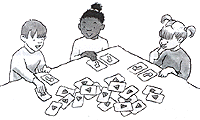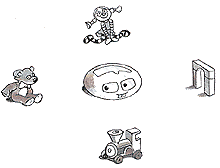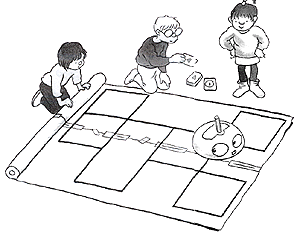
|
Feedback Form
| Summary | Basic activities | Forwards and backwards | Turning | Roamer Music |
 |
Before programming the Roamer it is a good idea to introduce the concept of turning and direction of turn without the robot.
1
 Select all
the Turning cards from the Roamer Playing Cards or similar. Shuffle them
and place them face down randomly on the table. Each child should take
it in turns to turn over two. If they are the same they can keep them
and turn over another two. If they do not match they must turn them back
and the next child takes their turn.
Select all
the Turning cards from the Roamer Playing Cards or similar. Shuffle them
and place them face down randomly on the table. Each child should take
it in turns to turn over two. If they are the same they can keep them
and turn over another two. If they do not match they must turn them back
and the next child takes their turn.
Although there are only two directions of turn represented - right and left - because the cards sometimes come out upside down, this activity is not as simple as it seems. Using body geometry helps enormously with turning and understanding left and right.

2
Change the unit of turn on Roamer (see Important Information).
Demonstrate  1 GO and
then
1 GO and
then  1 GO.
1 GO.
Place Turning cards in one pile face down and Number cards up to 4 in
another. Put a different object at each of the 90 degree points round
Roamer.
Each child, in turn, can pick one Turning card and one Number card and
program Roamer accordingly. They should say which object they think Roamer
will stop at before pressing GO.
Angles can be understood either as a turning movement between two points or as a measurement. This activity expresses the first idea and helps reinforce direction of turn.


3
Place a pen down the centre of Roamer and work on a large area of paper
(the back of a roll of wallpaper is ideal). Select all the Movement cards
(forwards, backwards, right and left) and place them face down in a pile.
Place a 1 face up next to them.
Then each child, in turn, picks a card from the pile and programs Roamer
with that movement and the 1. Repeat this activity until Roamer has created
an interesting pattern that the children can colour in.

This activity introduces the idea of angles as a measurement because the children can see the angles that are created. It is a great activity for reinforcing the concepts of shape and space and of course, when it comes to colouring in, it helps develop fine motor control.
